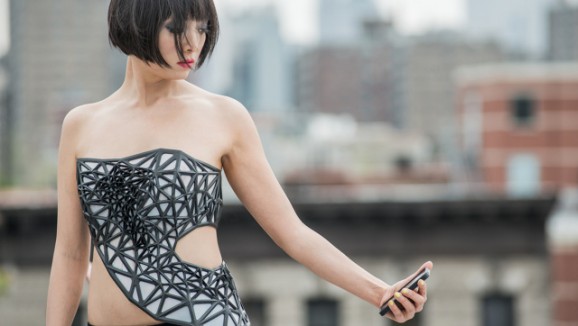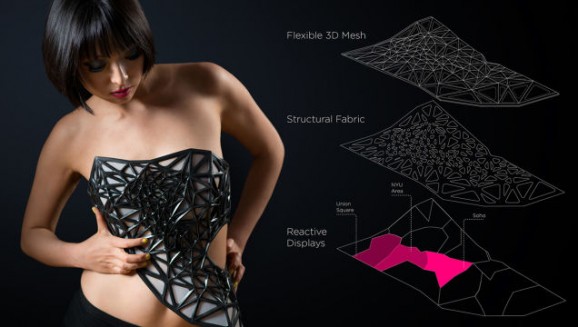3D-Printed Dress Responds To Wearers’ Available Data
This article is more than 2 years old
 Wearable technology isn’t just for astronauts, scientists, or crime fighters these days. There are now 3D-printed dresses and other fashions, dresses that illuminate and shift around when someone’s looking at them, and dresses that become more transparent and revealing as the wearer becomes aroused. Technology may inhibit our ability to express ourselves in some ways, such in as face-to-face conversations, but hey, at least our clothing can help make up for it, right? Now, there’s a new 3D-printed dress that reveals more and more of the user’s skin, but not in response to arousal or others’ gazes. This new dress responds to the amount of information the wearer reveals via the internet and social media.
Wearable technology isn’t just for astronauts, scientists, or crime fighters these days. There are now 3D-printed dresses and other fashions, dresses that illuminate and shift around when someone’s looking at them, and dresses that become more transparent and revealing as the wearer becomes aroused. Technology may inhibit our ability to express ourselves in some ways, such in as face-to-face conversations, but hey, at least our clothing can help make up for it, right? Now, there’s a new 3D-printed dress that reveals more and more of the user’s skin, but not in response to arousal or others’ gazes. This new dress responds to the amount of information the wearer reveals via the internet and social media.
We’ve all been inundated with articles and warnings about the unprotected state of our personal information, but studies show that, while people care about their compromised privacy, it seems that most of us remain vulnerable to hacking and other forms of surveillance. While studies also show that younger folks are just as concerned about their privacy as older folks, I do wonder if the consequences of privacy violations are less real to younger users (as so many other consequences are), or if any of us can really grapple what it means to have our data harvested — particularly by our own government. One way to impress upon people the impact of having their data up for grabs is by creating something physical that can manifest those vulnerabilities, such as a dress that bears the wearer’s skin as the wearer bears information.

Two students from NYU, Pedro Oliveira and Xuedi Chen, created a funky sculpture dress called “x.pose” that links up to an app that measures how much information the user shares about herself, both intentionally and inadvertently. The app basically tracks how “transparent” a user has made herself in the world of social media, and transmits that information to the dress, which becomes less opaque the more data is revealed. They wanted to merge data visualization and fashion to comment on the ways in which people both worry about their privacy but also strive for greater publicity online.
“In the physical realm we can deliberately control which portions our bodies are exposed to the world by covering it with clothing. In the digital realm, we have much less control of what personal aspects we share with the services that connect us. In the digital realm we are naked and vulnerable,” says Chen.
On her website, Chen also calls out Google and Facebook as companies that try to convince us that our personal information is a good trade for their “free” services. Chen is pretty honest about the fact that she’s essentially “already ceded control of [her] data,” and has decided to “go a step further and broadcast it for anyone and everyone to see.” She first built the mobile app to collect her data. She then used that data to design a wearable piece out of 3D-printed mesh that’s comprised of data points the mobile app collected over the course of a month. The pattern of those points actually helped produce the pattern of the mesh. The mesh then changes in transparency based on real-time data transmissions routed through a Bluetooth and an Arduino.
Anyone who wears this piece should probably expect to be mostly naked most of the time.












